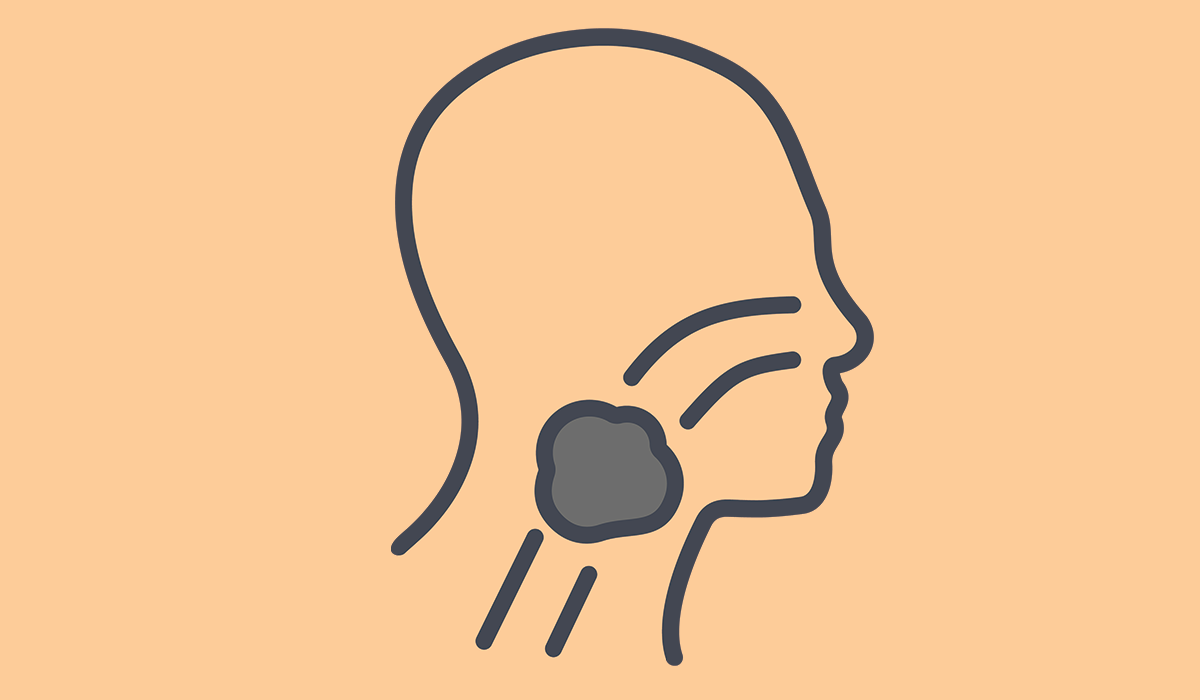
the possibility of developing it increases in smokers and older people. The prognosis depends mainly on the type of cancer and its stage.
Causes
Throat cancer can have various causes. Lifestyle, environmental factors, and genetic predisposition all influence the development of the disease. What causes it also depends on the type of cancer and where it develops.
Viral Infection
In the case of oropharyngeal cancer, the most common cause is infection with the human papillomavirus. This pathogen is mainly transmitted sexually. This is why oral sex may increase the risk of developing the disease. The virus causes infections on the genitals that can be cured. Many infections are asymptomatic and resolve spontaneously. However, in some situations, HPV can have serious consequences. HPV-16 is a highly oncogenic virus, which is also responsible for cancer of the cervix, anus, and other areas covered with squamous cells.

Smoking
One of the main risks for all types of throat cancer is tobacco use. Smoking cigarettes, cigars, and pipes significantly increases the risk, as the smoke inhaled contains carcinogens that damage the cells of the mouth, throat, larynx, and tonsils. The likelihood of developing cancer depends on how long and how intensively a person smokes. The more, the greater the risk, of course.
Alcohol Consumption
Another harmful stimulant is alcohol. Drinking strong alcoholic beverages also increases the possibility of throat cancer. It is especially when combined with smoking! The mix of these two factors is an extremely high risk.
Chemical Pollution
People exposed to toxic chemicals are also at risk of developing throat cancer. Asbestos, a fibrous mineral whose particles float in the air and can seriously damage health when inhaled, is particularly dangerous. It was once commonly used in construction and the automotive industry, so people working in the demolition or renovation of old buildings or repairing vehicles are at increased risk.
Poor Diet
Some research points to a connection between low fruit and vegetable consumption and a higher chance of developing throat cancer. This is probably due to insufficient amounts of vitamins and antioxidants, which help the body protect itself from harmful factors.
Symptoms
People frequently mistake the signs of throat cancer for milder conditions, which delays diagnosis. One of the first signs may be a sore throat that persists over time and does not respond to treatment, such as antibiotics. Such pain often intensifies when swallowing, radiates to the ear, and can lead to dysphagia, or difficulty eating, which in turn results in weight loss.
Another common symptom is a change in voice, persistent hoarseness indicating excessive strain on the vocal cords. This usually occurs in the more advanced stages of the cancer.
Other worrying symptoms include blood in the sputum, bad breath, and a persistent cough. In advanced cases, the tumour may compress the windpipe, leading to breathing problems. Visible swelling of the neck may indicate both a tumour and metastasis to the lymph nodes.

Complications
As throat cancer progresses, more and more troublesome problems arise. One of the most serious is increasing difficulty swallowing, which leads to weight loss and malnutrition. The body then becomes weakened and less able to cope with the disease.
When the tumour begins to compress the airways, breathing becomes increasingly difficult, and sometimes surgical intervention, such as a tracheostomy, is necessary. If the cancer affects the vocal cords, it can lead not only to chronic hoarseness but even to complete loss of voice, which significantly impairs communication with others.
Throat cancer can also spread to other parts of the body, causing what are known as metastases. It usually moves first to nearby lymph nodes. However, in some cases, it also spreads to more distant sites, such as vital organs or bones. Unfortunately, such cases are more complicated and hard to treat.
Diagnosis
To diagnose throat cancer, a physician must perform several diagnostic procedures. First, they collect a medical history, then thoroughly examine the throat, mouth, and neck, looking for lesions, lumps, or swelling. If cancer is suspected, imaging tests and a biopsy are necessary. These allow for the assessment of hard-to-reach parts of the throat and oesophagus. A quick and accurate diagnosis gives the chance to develop effective treatment and increases the likelihood of recovery.
Imaging Tests
Computed tomography is important in diagnosing throat cancer because it allows the doctor to view the throat, neck, and surrounding areas from different angles. This allows them to assess the size of the tumour, its exact location, and whether the cancer has spread to the lymph nodes. The doctor often performs additional positron emission tomography (PET) and magnetic resonance imaging (MRI) scans. MRI helps to show the tumour’s connections to nerves and blood vessels in detail. Imaging tests provide a precise picture of the tumour, which is essential for performing a biopsy correctly and planning treatment.

Biopsy
A biopsy helps the doctor determine whether the spots detected in imaging tests contain malignant cells. Most often, they take the sample during an endoscopy, which allows for a thorough examination of the lesions and the collection of a small piece of tissue for histopathological examination. If the tumour is easily accessible, the doctor may skip the endoscopy and perform an incisional or excisional biopsy, which involves removing part or all of the tumour. The procedure is done under local or general anaesthesia, depending on the patient’s needs and the location of the tumour.
Treatment
Throat cancer is a serious disease whose treatment requires a multifaceted approach and close cooperation between a team of specialists. Treatment for throat cancer usually involves a special surgical procedure. However, doctors also use radiotherapy and chemotherapy. They choose the appropriate method depending on the location of the tumour, but the size and stage of the cancer are also important. The duration of treatment may vary, but patients should be aware that it is likely to be lengthy. After the procedure, a recovery period is needed, which can last weeks or months. Radiotherapy and chemotherapy are administered cyclically, which also takes a long time. However, it is very important to stick to the treatment plan in order to improve the prognosis for throat cancer.
Surgery
Surgery, especially in the early stages of throat cancer, effectively treats the disease and removes the tumour while trying to preserve as much of the throat and surrounding structures as possible. One of the less invasive methods is transoral robotic surgery (TORS), which allows for the precise removal of the tumour through the mouth. In some cases, especially when the tumour covers large areas, surgery can cause difficulty in speaking and swallowing and reduce quality of life.
In more advanced stages, doctors may decide to remove part of the tongue, palate, or other structures responsible for speech and swallowing. Sometimes a laryngectomy is an option, which removes the vocal cords, making it impossible for the patient to speak normally. In such situations, patients are assisted by alternative methods of communication. They use voice prosthesis, which is a special device that allows them to make sounds and communicate with others.
Radiotherapy
Radiotherapy effectively treats early stages of throat cancer and often supports treatment after surgery, eliminating remaining cancer cells. Doctors use various methods of radiotherapy. In external type radiotherapy, they direct radiation precisely at the cancerous tumour, while in brachytherapy, they place the radiation source directly in the tumour. The latter method delivers a highly concentrated dose, which increases the effectiveness of the treatment. However, patients may experience side effects such as skin or mucous membrane irritation.
Chemotherapy
Chemotherapy is an important part of throat cancer treatment. Doctors administer special drugs that destroy or inhibit the growth of cancer cells. Sometimes it is used on its own, but more often it is combined with other methods, such as radiotherapy. Patients who receive chemotherapy after surgery usually have a better chance of survival.

Prognosis
The prognosis for throat cancer varies depending on the stage of the disease at the time of diagnosis and treatment initiation. Patients with oropharyngeal carcinoma have a five-year survival rate of approximately 60% after diagnosis. If the cause of cancer is HPV infection, the prognosis is usually better, and the cancer responds better to treatment. Laryngeal cancer has a similar prognosis, and patients’ chances improve when they quit smoking. Head and neck cancer has a good prognosis (60 to 95%) if doctors detect it early and use localised treatment. Unfortunately, in the later stages, the risk of recurrence or metastasis increases, and cancer of the lower throat usually has poorer treatment outcomes.
Sources
- Zohaib Jamal, Fatima Anjum (2023). Oropharyngeal Squamous Cell Carcinoma. https://www.ncbi.nlm.nih.gov/books/NBK563268/
- Antony Koroulakis, Manuj Agarwal (2024). Laryngeal Cancer. https://www.ncbi.nlm.nih.gov/books/NBK526076/
- Ana Lívia Silva Galbiatti, João Armando Padovani-Junior, José Victor Maníglia, Cléa Dometilde Soares Rodrigues, Érika Cristina Pavarino, Eny Maria Goloni-Bertollo (2015). Head and neck cancer: causes, prevention and treatment. https://pmc.ncbi.nlm.nih.gov/articles/PMC9443822/

Hip Pain: What Is, Causes, Diagnosis, and Prognosis
H Pylori: What Is, Symptoms, Diagnosis, and Treatment

Blackheads: What Are, Types, Causes, and Skin Care
Spondylosis: What Is, Causes, Complications, and Prognosis

White Blood Cells: What Are, Types, Function, and Testing

Vitamin A: What Is, Roles, Deficiency, and Excess

Eosinophils: What Are, Anatomy, Functions, and Conditions

Biotin: What Is, Uses, Biotin Deficiency, and Dosing
Amyloidosis: What Is, Signs, Diagnosis, and Treatment

Chromosome: What Is, Functions, Conditions, and How To Treat
Squamous Cell Carcinoma: What Is, Symptoms, and Treatment

Angina: What Is, Causes, Symptoms, and Diagnosis

Hyperkalemia: What Is, Signs, Diagnosis, and Treatment

Diabetes: What Is, Types, Symptoms, and Diagnosis

Endocrinologist: Who Is, Endocrinology, and Different Kinds
